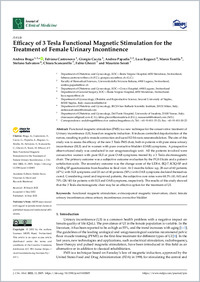Efficacy of 3 Tesla functional magnetic stimulation for the treatment of female urinary incontinence
- Braga, Andrea ORCID Department of Obstetrics and Gynecology, EOC—Beata Vergine Hospital, Mendrisio, Switzerland ; Faculty of Biomedical Sciences, Università della Svizzera italiana, Switzerland
- Castronovo, Fabiana Department of Obstetrics and Gynecology, EOC—Beata Vergine Hospital, Mendrisio, Switzerland
- Caccia, Giorgio Department of Obstetrics and Gynecology, EOC—Beata Vergine Hospital, Mendrisio, Switzerland
- Papadia, Andrea Faculty of Biomedical Sciences, Università della Svizzera italiana, Switzerland ; Department of Obstetrics and Gynecology, EOC—Civico Hospital, Lugano, Switzerland
- Regusci, Luca Department of General Surgery, EOC—Beata Vergine Hospital, Mendrisio, Switzerland
- Torella, Marco Department of Gyanecology, Obstetric and Reproductive Science, Second University of Naples, Naples, Italy
- Salvatore, Stefano Department of Obstetrics and Gynecology, IRCSS San Raffaele Scientific Institute, Milan, Italy
- Scancarello, Chiara Department of Obstetrics and Gynecology, Del Ponte Hospital, University of Insubria, Varese, Italy
- Ghezzi, Fabio Department of Obstetrics and Gynecology, Del Ponte Hospital, University of Insubria, Varese, Italy
- Serati, Maurizio Department of Obstetrics and Gynecology, Del Ponte Hospital, University of Insubria, Varese, Italy
- 2022
Published in:
- Journal of clinical medicine. - 2022, vol. 11, p. 2805
Functional magnetic stimulation
Extracorporeal magnetic innervation
Chair
Female urinary incontinence
Stress urinary incontinence
Overactive bladder
English
Functional magnetic stimulation (FMS) is a new technique for the conservative treatment ofUrinary incontinence (UI), based on magnetic induction. It induces controlled depolarization of thenerves, resulting in pelvic muscle contraction and sacral S2-S4 roots neuromodulation. The aim of thisstudy was to assess the efficacy of the new 3 Tesla FMS chair, both in patients with pure stress urinaryincontinence (SUI) and in women with pure overactive bladder (OAB) symptoms. A prospectiveobservational study was conducted in our urogynaecologic unit. All the patients involved wereconsecutive women with pure SUI or pure OAB symptoms treated by a 3 Tesla electromagneticchair. The primary outcome was a subjective outcome evaluation by the PGI-I Scale and a patient-satisfaction scale. The secondary outcome was the change score of the UDI-6, IIQ-7, ICIQ-SF andOAB-q SF questionnaires from baseline to final visit. At 2 months follow-up, 28 out of 60 patients(47%) with SUI symptoms and 20 out of 40 patients (50%) with OAB symptoms declared themselvescured. Considering cured and improved patients, the subjective cure rates were 68.3% (41/60) and70% (28/40) for patients with SUI and OAB symptoms, respectively. The results of this study showedthat the 3 Tesla electromagnetic chair may be an effective option for the treatment of UI.
- Collections
- Language
-
- English
- Classification
- Medicine
- License
- Open access status
- gold
- Identifiers
-
- DOI 10.3390/jcm11102805
- ARK ark:/12658/srd1325639
- Persistent URL
- https://n2t.net/ark:/12658/srd1325639
Statistics
Document views: 108
File downloads:
- Braga_2022_MDPI_jcm: 332
